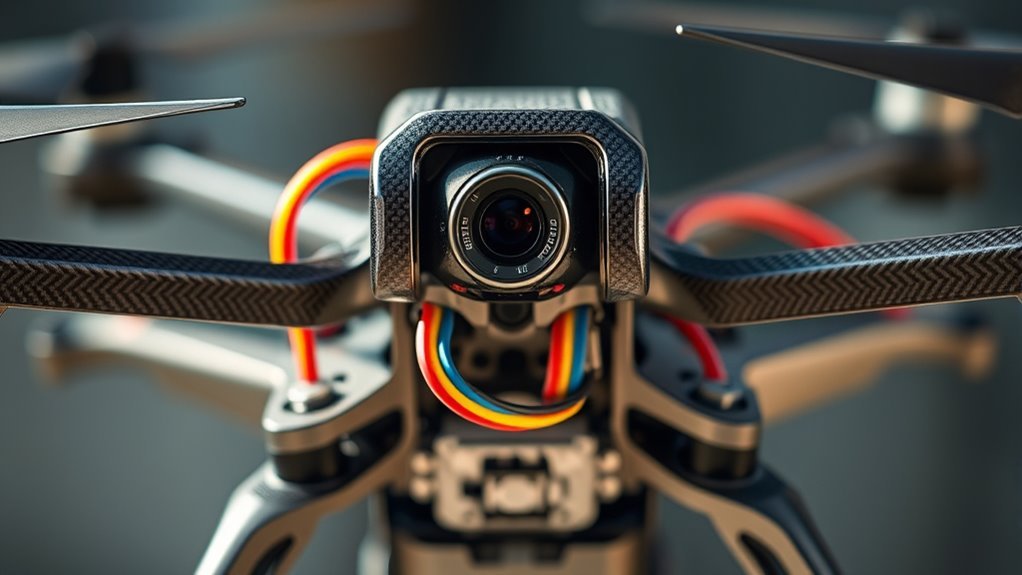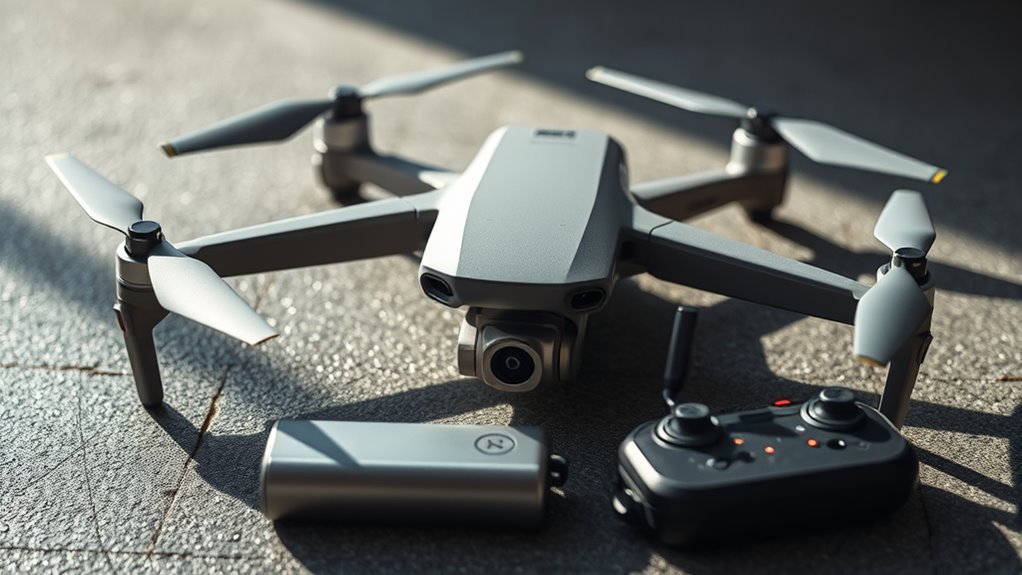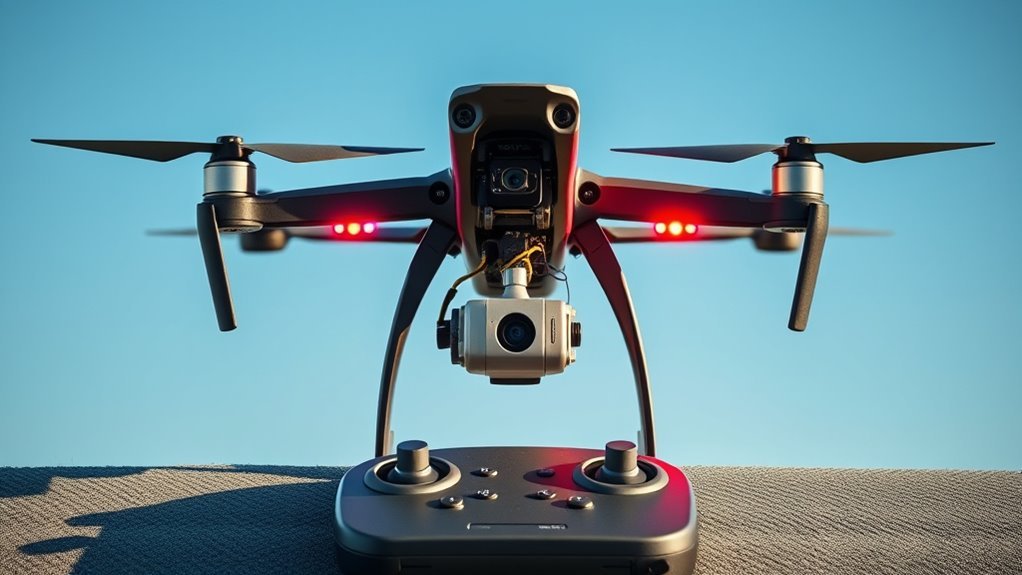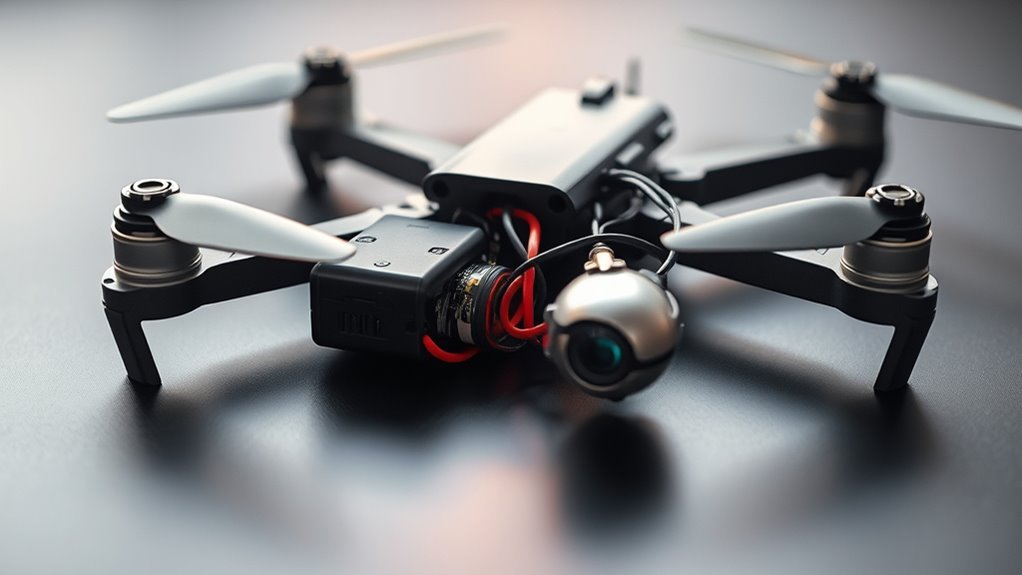Drones rely on several key components for ideal performance. You’ll find propulsion systems that include motors and propellers, along with efficient battery management for extended flight times. The flight controller is essential for stability, integrating various sensors for navigation and real-time data interpretation. Communication systems guarantee control signal transfer, while advanced cameras capture high-quality images. A robust chassis design contributes to durability. These elements work together, and exploring them further reveals more about their interconnectivity and impact on drone capabilities.
Propulsion System

The propulsion system is the heart of a drone, providing the necessary thrust to achieve flight. It consists primarily of motors, propellers, and battery systems, each meticulously designed to maximize propulsion efficiency. You’ll find that higher efficiency translates into longer flight times and reduced energy consumption, which is vital for exploration and autonomy. Thrust control plays an important role in maneuverability, allowing you to adjust the drone’s altitude and direction with precision. By fine-tuning motor speeds, the system can respond to varying conditions, ensuring stable flight and adaptability. Furthermore, understanding the transmission technologies of your drone can enhance its operational range and effectiveness. Understanding these components empowers you to optimize your drone’s performance, expanding your freedom to explore the skies without constraints. Additionally, the flight performance and maneuverability of a drone can significantly impact its operational capabilities. Embrace the technology, and let it elevate your aerial adventures.
Flight Controller

The flight controller is the brain of your drone, essential for navigation and stability. It integrates various sensors to interpret real-time data, ensuring precise control during flight. Additionally, keeping your firmware and software updated is vital for optimizing performance and adding new features. Moreover, the flight controller plays a critical role in managing intelligent flight modes that enhance user experience and enable complex maneuvers. The integration of GPS and sensor technologies further enhances the flight controller’s ability to maintain precise flight paths with minimal deviation.
Role in Navigation
While maneuvering through complex environments, a drone’s flight controller plays an essential role in guaranteeing stable and accurate flight. This component integrates GPS technology for precise location tracking, allowing you to navigate with confidence. The flight controller processes data from the GPS, calculating the drone’s position and making real-time adjustments to maintain stability. When conducting aerial mapping, the flight controller guarantees that your drone follows predetermined flight paths, capturing high-quality images and data efficiently. By continuously monitoring and adjusting for factors like wind and altitude, the flight controller provides the freedom to explore various landscapes without sacrificing control. Ultimately, this technology empowers you to execute precise maneuvers, enhancing your aerial adventures.
Sensor Integration Features
In addition to its navigation capabilities, the flight controller’s sensor integration features greatly enhance a drone’s functionality and adaptability. By utilizing various sensor types, the flight controller processes data seamlessly, allowing for real-time adjustments and improved performance. Key aspects of sensor integration include:
- GPS sensors for precise location tracking
- Barometers for altitude monitoring
- Accelerometers and gyroscopes for stabilization and orientation
- Magnetometers to detect heading and magnetic fields
With these integrations, your drone can respond intelligently to environmental changes, ensuring smooth operations. The ability to analyze and process data from multiple sensors empowers you to explore new horizons with confidence, making your experience freer and more exhilarating.
Firmware and Software Updates
Regularly updating the firmware and software of your flight controller is essential for optimizing drone performance and guaranteeing safety. Firmware upgrades can enhance flight stability, improve navigation accuracy, and fix bugs that may affect operation. Keeping your software compatible with the latest updates not only extends your drone’s capabilities but also integrates new features that can elevate your flying experience. Additionally, outdated software can lead to compatibility issues with other components, leading to potential malfunctions. You should regularly check for updates from the manufacturer and follow their guidelines for installation. By taking these proactive steps, you guarantee your drone operates at peak performance, allowing you to explore the skies with confidence and freedom.
Battery and Power Management

Understanding battery and power management is essential for maximizing a drone’s performance and flight time. By focusing on these components, you’ll enhance both battery life and power efficiency, allowing for longer, uninterrupted flights. Here are a few key elements to take into account:
- Battery Type: Lithium-polymer (LiPo) batteries are popular for their high energy density.
- Capacity Ratings: Measured in milliamp-hours (mAh), capacity impacts flight duration.
- Power Distribution: Efficient distribution helps prevent voltage drops during flight.
- Smart Battery Management Systems: These monitor voltage and temperature, ensuring safety and longevity. Additionally, the advanced battery optimization techniques employed by drones help regulate power consumption for extended flight times.
Motors and Propellers
Battery performance directly influences the choice and efficiency of motors and propellers in a drone. Selecting the right motor types—such as brushed or brushless—can greatly affect your drone’s power output and overall flight duration. Brushless motors, for instance, offer higher efficiency and longevity, making them ideal for serious enthusiasts.
In tandem, propeller materials play an essential role in performance. Carbon fiber propellers provide superior strength and reduced weight, enhancing maneuverability and responsiveness. Conversely, plastic propellers are lighter and less expensive but may sacrifice durability and efficiency.
As you design your drone, consider how these components synergize with the battery’s capabilities, maximizing your flight experience while ensuring freedom in your aerial adventures.
Sensors and Navigation
While you might focus on motors and propellers, the importance of sensors and navigation systems in a drone cannot be overstated. These components enable precise control and enhance the drone’s capabilities, allowing you to explore freely.
- Sensor types: Cameras, LiDAR, ultrasonic, and GPS are vital for data collection and environmental awareness. Understanding signal range is crucial for effective operation as it directly affects communication with the drone.
- Navigation techniques: These include GPS waypoint navigation, visual tracking, and inertial navigation systems. Maintaining visual line of sight is essential for safe navigation and compliance with regulations.
- Obstacle detection: Sensors help avoid collisions, ensuring safe flight paths.
- Stabilization: Using gyroscopes and accelerometers, drones maintain stability in various conditions. Additionally, advanced stability mechanisms provide enhanced flight control for smooth precision maneuvers.
Communication Systems
Communication systems are the backbone of drone operation, facilitating real-time data exchange between the drone and its operator. These systems rely on various communication protocols to guarantee efficient signal transmission, enabling you to control the drone effectively and receive essential information during its mission.
Here’s a quick overview of key communication components:
| Component | Function |
|---|---|
| Transmitter | Sends control signals to the drone |
| Receiver | Captures signals from the drone |
| Antenna | Enhances signal strength and range |
| Communication Protocols | Defines the rules for data exchange |
| Frequency Bands | Allocates specific ranges for signal transmission |
Understanding these elements can greatly enhance your operational efficiency and control over the drone, allowing for more freedom in your aerial endeavors. Additionally, effective communication systems can mitigate challenges related to environmental factors that may impact signal clarity during drone operations.
Camera and Imaging Equipment
Camera and imaging equipment are pivotal for capturing high-quality visuals and data during drone operations. With advancements in technology, you can select components that suit your specific needs, enhancing your aerial capabilities. Key considerations include:
Selecting the right camera and imaging equipment is crucial for optimizing drone operations and achieving superior visual results.
- Image resolution: Higher resolutions provide clearer, more detailed images, essential for analysis.
- Lens types: Different lenses offer varied fields of view and depth of field, impacting the overall imagery.
- Stabilization systems: These reduce vibrations, ensuring steady shots even in turbulent conditions.
- Sensor capabilities: Advanced sensors can adapt to different lighting conditions, improving image quality. Additionally, incorporating high-resolution cameras can significantly enhance defect detection and streamline quality control efforts.
Software and Firmware
To maximize the effectiveness of the imaging equipment, robust software and firmware are necessary components of a drone’s ecosystem. The software architecture must be designed to manage complex tasks, including flight control and data processing, guaranteeing seamless integration with hardware. You’ll want the firmware optimization to be tailored for real-time responsiveness, enhancing stability and performance during operations. This combination allows for efficient resource management, which is vital when deploying drones in various environments. Additionally, user-friendly interfaces empower operators to manipulate settings and access advanced features, further revealing the drone’s potential. Ultimately, focusing on these software and firmware aspects guarantees you harness the full capabilities of your drone, giving you the freedom to explore and innovate without limitations. Furthermore, advanced collision avoidance and security features ensure that drones can operate safely in complex environments, minimizing the risk of accidents. The integration of AI and IoT enhances the adaptability and efficiency of drone operations, creating a seamless network for real-time data processing and analysis.
Chassis and Frame Design
The chassis and frame design of a drone serves as its backbone, providing structural integrity and stability during flight. Choosing the right chassis materials is essential for enhancing frame durability while minimizing weight. A well-designed frame guarantees your drone can withstand various conditions, delivering peak performance.
- Carbon fiber: Lightweight yet strong, ideal for racing drones
- Aluminum: Offers a balance of durability and weight
- Plastic composites: Cost-effective and versatile for hobbyist drones
- Wood: Traditional choice, providing unique aesthetic qualities
Additionally, the robust construction of a drone, such as that of the Exo X7, ensures long-term use and resilience against environmental challenges. The material choice impacts durability and user experience, particularly in varying usage environments.
Frequently Asked Questions
How Long Can a Drone Fly on a Single Battery Charge?
A drone’s battery life directly affects its flight duration. Generally, you can expect between 20 to 30 minutes on a single charge, but factors like weight, weather, and battery type can greatly influence performance.
What Materials Are Commonly Used for Drone Frames?
When considering drone frames, you’ll often find carbon fiber and aluminum alloy as common materials. Carbon fiber offers lightweight strength, while aluminum alloy provides durability. Both materials enhance performance, giving you the freedom to explore the skies efficiently.
How Do Weather Conditions Affect Drone Performance?
Imagine flying a kite; similarly, weather conditions impact your drone’s performance. Wind resistance can destabilize flights, while temperature effects can alter battery efficiency, reducing flight time and control. Always consider these factors before taking off.
Can Drones Be Equipped With Multiple Cameras?
Yes, you can equip drones with multiple cameras, utilizing various camera types. Multi-camera setups enhance versatility, enabling you to capture different perspectives and improve data collection, giving you the freedom to explore diverse aerial applications.
What Is the Typical Lifespan of Drone Components?
The typical lifespan of drone components varies considerably. Factors like component durability, usage intensity, and environmental conditions affect longevity. Regular maintenance can enhance performance, ensuring you maximize your equipment’s lifespan while enjoying your aerial adventures.

